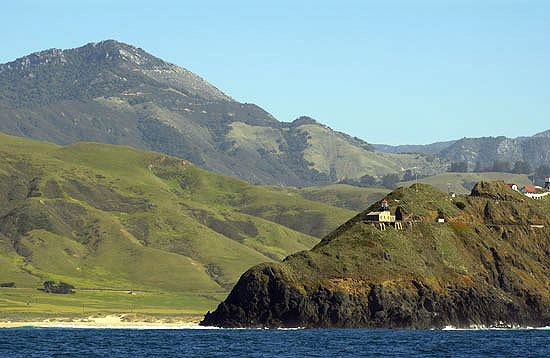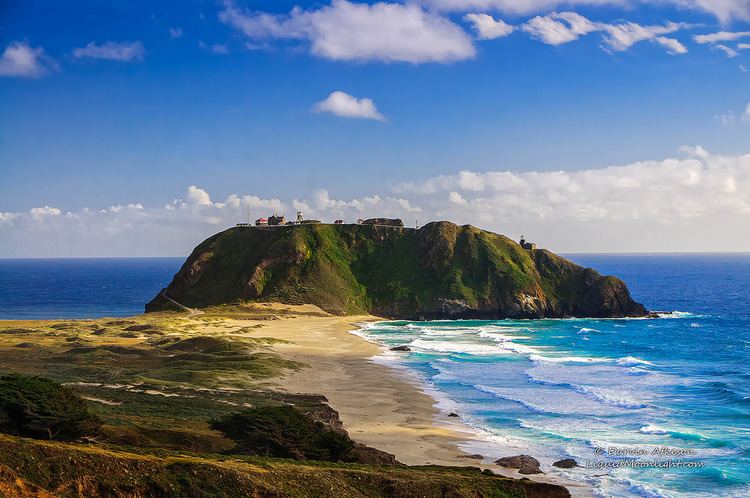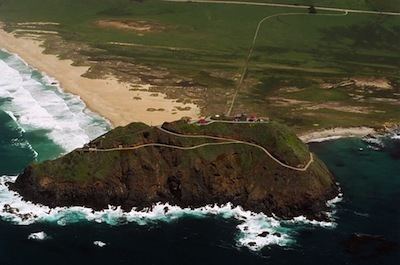Year first constructed 1889 Focal height 270 ft (82 m) Construction started 1889 Area 15 ha Added to NRHP 3 September 1991 | Automated 1972 Height 15 m Opened 1889 Material Sandstone | |
Tower shape square parallelepiped tower with balcony and lantern attached to fog signal building Markings / pattern unpainted tower,black lantern Similar Point Sur State Historic P, Andrew Molera State Park, Bixby Creek Bridge, Point Pinos Lighthouse, Point Sur Naval Facility | ||
Point sur lighthouse
Point Sur Lightstation is a lighthouse at Point Sur, California, 135 miles (217 km) south of San Francisco, on the 361-foot (110 m)-tall rock at the head of the point. It was established in 1889 and is part of Point Sur State Historic Park. The light house is 40 feet (12 m) tall and 270 feet (82 m) above sea level. As of 2016, and for the foreseeable future the light is still in operation as an essential aid to navigation. The lightstation is part of Point Sur State Historic Park. Point Sur is the only complete turn-of-the-20th-century lightstation open to the public in California. Three-hour walking tours guided by volunteers are available on Wednesdays and weekends throughout the year.
Contents
- Point sur lighthouse
- Dji phantom point sur lighthouse 1080p hd big sur california
- Light sources
- Foghorns
- Structures
- Marine protected areas
- History
- Head lightkeepers
- Shipwrecks
- In popular culture
- References

Dji phantom point sur lighthouse 1080p hd big sur california
Light sources

The lighthouse has had four different light sources during its history. First, it had an oil wick lamp, and then an oil vapor lamp. Three different fuels were used: whale oil, lard oil, and kerosene. Later, two different kinds of electric lights were used.

The Station emitted a beam of light which swept across the arc to seaward of the Point. The lamp's light was concentrated into a beam with a first-order Fresnel lens. The lens was almost 9 feet (3 m) tall, weighed 4,330 pounds, and consisted of 580 separate glass prisms. The entire structure, including the pedestal and clockworks was 18 feet (5 m) tall and weighed 9,570 pounds (4,341 kg).

Currently, the original first-order Fresnel lens along with the clockworks are on display at the Museum of Monterey in nearby Monterey, California.
Foghorns
In dense fog, the light beam might not be visible, so the lighthouse had a foghorn to alert ships. A coal-powered foghorn was installed when the light was used, but this labor-intensive system was replaced as soon as better technology was available. In 1972, the “Super Tyfon Double Fog Signal,” named after the giant Typhon from Greek mythology, was put into use. This system consisted of two compressed air horns sounding simultaneously, and could be heard up to 3 nautical miles (6 km) away. The modern electric tone fog signal was a 12 volt high frequency fog signal with a sound range of half a nautical mile. The high frequency was very effective in fog.
Structures
The staff of the station consisted of a head keeper and three assistant keepers. The families of the keepers lived with them at the station. The Station had a residence for the head keeper and his family, and another for the assistant keepers.
The lighthouse keepers and their families lived in isolation at Point Sur. Therefore, the station included all facilities needed for them to be self-sustaining. There was a cistern which held 53,000 US gallons (200,627 l) of water (later replaced by a water tower), and a pump house which brought up water from a well in the sand flats at the base of the rocks.
There was a barn, where horses and cattle were kept. The carpenter and blacksmith shop held supplies for the keepers to do their own construction, since Monterey was a full day's trip away until the 1930s. The lamp tower, oil room, and fog signal room were all combined into one building because of limited space.
Marine protected areas
Point Sur State Marine Reserve and Marine Conservation Area is a marine protected areas offshore from Point Sur Lighthouse. Like underwater parks, these marine protected areas help conserve ocean wildlife and marine ecosystems.
History
Point Sur was a hazard for ships from the first settlement of California, and especially after the great increase in shipping in the mid-19th century, after the California Gold Rush. Many ships were wrecked there.
In 1875, the ship Ventura ran onto rocks just north of Point Sur, and many people died. Though the Ventura's captain was drunk, the absence of a light contributed to this tragedy.
The board of the United States Lighthouse Service (USLS) stated in 1874 that “Point Sur is the most important point and should be the site of a lighthouse. In considering the various points on the California coast where lighthouses are still required, Point Sur claims the place of greatest importance." The board repeated this recommendation, and California citizens submitted petitions in support. In 1885, the board stated that "this dangerous point, which is still unlighted, is made subject of much complaint."
Finally, in 1886, Congress appropriated $50,000 for construction of a lighthouse at Point Sur, and another $50,000 in 1887.
Twenty-five men were employed in the construction of the lighthouse and adjacent buildings. They built a road from the mainland to the rock, blasted a trail to the top of the rock, quarried stone, and built a tramway from the shore to the peak. By the end of the first year, all the rock had been quarried and construction of many buildings was well underway. The Lighthouse Board hoped the construction would be completed by the end of 1888, but an additional $10,000 was needed before the light station was completed and the lantern lit on August 1, 1889. (Point Sur is technically a light station, as opposed to a lighthouse, because it consists of multiple buildings.)
Life on Point Sur was very isolated. The only road, which led to Monterey, was long and often dangerous. The keepers received goods and bulk supplies by boat roughly every four months. A “lighthouse tender” brought the supplies, but to get them ashore, the supplies were transferred to skiffs and floated to land in barrels.
Highway 1 was completed in 1937, connecting Big Sur with Monterey to the north and San Luis Obispo to the south. Prior to the construction of Highway 1, the California coast south of Carmel and north of San Simeon was one of the most remote regions in the state, rivaling nearly any other region in the United States for its difficult access. Life on the Point Sur became less isolated.
The site is now registered as California Historical Landmark #951. In 1991, the old lighthouse and a 37-acre (15 ha) area was listed on the U.S. National Register of Historic Places as Point Sur Light Station. In 2004, the Coast Guard transferred the building and land to California Department of Parks and Recreation.
Head lightkeepers
Shipwrecks
Notable shipwrecks occurring near Point Sur:
In popular culture
In 1967, the lighthouse (including the lantern room) and its surrounding buildings, were used as a filming location for an episode of the WWII-themed TV series, The Rat Patrol, entitled "The Two If By Sea Raid" (airdate: 12/18/67), standing in for a Nazi-held light on the Mediterranean coast of North Africa. The light was automated by the United States Coast Guard in 1972.
The original Fresnel lens was moved to the Maritime Museum of Monterey, where it was an exhibit. Recently, the Maritime Museum of Monterey ceased operation and was subsequently renamed the Museum of Monterey. The museum no longer wanted to maintain the Fresnel lens in its collection and efforts are underway to return the lens to its original location at Point Sur Light Station.
